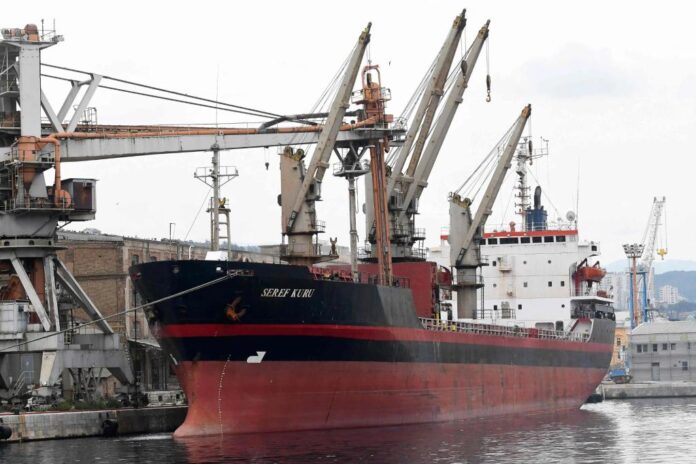
Ukraine’s 2023 counteroffensive has disappointed many in the West who were hoping for breakthroughs like last year’s liberation of Kharkiv and Kherson.
But critics are looking by land when they should also be looking by sea. Ukraine’s maritime wins, which include piercing Russia’s Black Sea blockade and forcing the Russian navy into retreat, are a lesson in restoring deterrence.
Since August, more than 130 vessels have sailed from Ukrainian ports and exported more than 5 million tons of goods, Ukraine’s Ministry of Infrastructure told me this week.
They sail in defiance of Vladimir Putin’s efforts to hold the global food supply hostage.
In July, Russia walked away from the Black Sea Grain Initiative.
Yet Ukraine broke the blockade and re-established a grain corridor without a naval escort from the United Nations or the North Atlantic Treaty Organization.
In addition, the Ukrainian government and more than a dozen British insurers are working to ensure exporters’ losses are covered in case of an attack.
Prime Minister Denys Shmyhal recently said Kyiv and London reached an agreement for a “special mechanism” that “will allow for a discount on the cost of war insurance for exporters of all products from Ukraine.”
Black Sea control
Resuming grain shipments is a major advance in a Ukrainian counteroffensive that has Russia’s Black Sea fleet scrambling.
For the war’s first year and a half, the Russians believed they could “dominate” the Black Sea, “dictate the rules there,” and that their “Black Sea fleet is completely safe and secure,” Mykhailo Podolyak, an adviser to President Volodymyr Zelensky, told me in September. The main goal now is “to eliminate Russia’s domination of the sea,” Podolyak said.
Zelensky cited the progress in a speech last month: “The Russian military fleet is no longer able to operate in the western part of the Black Sea and is gradually retreating from Crimea. This is a historic achievement.”
Ukraine’s Black Sea gains are notable given the differences between the two countries’ navies. Russia is one of the world’s great naval powers.
In Ukraine, by contrast, “we literally have almost no navy,” said former Defense Minister Andriy Zagorodnyuk, so recent gains prove “the asymmetric approach and the new-technology approach can take away old doctrines and old ways of warfare.”
Throughout the 2023 counteroffensive, Ukraine has used missiles and drones to drive back Russia’s navy.
Small groups of Ukrainians, some working out of garages, are developing kamikaze sea drones that have repeatedly inflicted damage on the Russian fleet.
Ukrainian sea-drone attacks in August damaged a Russian landing ship and struck a Russian oil tanker near the Kerch Strait Bridge linking Russia and Crimea.
In September, Ukraine seized control of oil and gas platforms in the Black Sea that Russia had been using as helipads and to conduct reconnaissance.
A few days later, a Ukrainian missile attack on Russia’s port in Sevastopol in occupied Crimea destroyed a landing ship and submarine and damaged one of the Black Sea fleet’s main repair facilities. Within days, Ukrainian drones and cruise missiles struck the headquarters of the Black Sea fleet in Sevastopol.
These blows led Russia to pull back. Ukraine’s naval spokesman said last month that the Black Sea fleet was moving some vessels from Sevastopol to Feodosia and Kerch, further east in Crimea, and to the Russian city of Novorossiysk.
On Nov. 4, Ukraine struck and damaged the Zalyv shipyard in Kerch — “the largest shipyard in Eastern Europe” and “likely the main repair facility” for Russia’s Black Sea fleet in Crimea after the September strike in the Sevastopol repair complex, according to the Institute for the Study of War.
Ukrainian officials said the attack also damaged a small Russian missile ship. And on Nov. 10, Ukrainian military intelligence said sea drones had sunk two small Russian landing ships near Chornomorsk, Crimea, adding that one of them had been laden with armored vehicles.
To date Ukraine has destroyed 15 Russian vessels and damaged an additional 12 in the Black Sea, Ukraine’s naval spokesman said Friday. Ukraine hasn’t overwhelmed Russia’s navy.
But “we have chipped away at their dominance,” Serhii Kuzan, head of the Ukrainian Security and Cooperation Center, a Kyiv think tank, told me this fall.
Missile threat
The counteroffensive hasn’t deprived Russia of long-range missiles that could strike anywhere in the Black Sea.
The Kremlin has repeatedly hit grain storage and export facilities in southwestern Ukraine. A missile strike on the port of Odessa this month hit a Liberian-flagged vessel at the port, killing one person and injuring four, including three Filipino crew members.
But Ukraine’s attacks have denied Russia the ability to operate in the Black Sea with impunity.
Russian ships can no longer safely sail near the grain corridor and interfere with shipping by colliding with freighters, firing warning shots or similar interdictory measures.
Putin must choose between sinking civilian ships owned by non-Ukrainians or allowing Ukraine’s grain corridor to operate — even though Russia warned it would no longer guarantee the safety of commercial vessels transiting these waters, says Fred Kagan, director of the Critical Threats Project at the American Enterprise Institute. So far, Putin has chosen not to escalate.
Reprinted from The Wall Street Journal. Melchior is a London-based member of the Journal editorial board.



